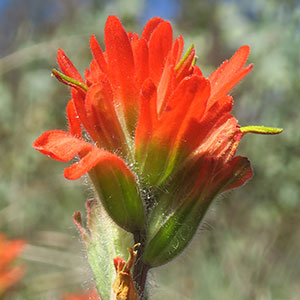Castilleja brevilobata
Castilleja wightii
short-lobed paintbrush
Wight's Indian paintbrush, Wight's paintbrush
solitary or few, erect or ascending, unbranched, sometimes branched, hairs spreading, short, medium, and long, soft, short and medium ones short stipitate-glandular.
few to many, ascending to erect, much-branched, usually with prominent leafy axillary shoots, hairs spreading, long, soft, mixed with shorter, stipitate-glandular ones.
green or ± yellow, lanceolate, elliptic, or oblong to narrowly ovate, 1–2(–2.5) cm, not fleshy, margins plane or wavy, involute, (0–)3–5(–7)-lobed, apex rounded to acute;
lobes ascending to erect, linear to lanceolate, apex rounded to acute.
green-tinged or ± purple, sometimes yellow-green tinged, densely crowded, linear, lanceolate, oblong, elliptic, or ovate, 1–7 cm, thickened, not usually fleshy, margins plane to wavy, involute or flat, 0–3(–5)-lobed, apex broadly rounded to obtuse or acute;
lobes spreading-ascending, linear, narrowly lanceolate, triangular, or rounded, apex acute, obtuse, or rounded.
3–20 × 2–3.5 cm;
bracts proximally greenish to dull brown, distally red, orange-red, or scarlet, sometimes orange or yellow, broadly lanceolate or oblong, (0–)3–5-lobed;
lobes ascending, broadly to narrowly lanceolate, short, arising above mid length, apex acute, obtuse, or rounded.
3–22 × 1.5–3.5 cm;
bracts proximally green to deep purple, rarely light tan, distally red, scarlet, rose, red-orange, or yellow, sometimes orange, dull brownish orange, pale pinkish tan, yellow aging white, yellow aging pink, red with pink apices, magenta, or white, sometimes with a yellow to deep purple medial band, lanceolate, oblong, or narrowly ovate, (0–)3–5(–7+)-lobed, distal margins of central lobe and sometimes also side lobes with multiple shallow teeth, proximal often wavy-margined;
lobes erect or ascending, linear to lanceolate or oblanceolate, short, arising in distal 2/3, apex obtuse to acute, central lobe often rounded to truncate.
0 mm or nearly so.
straight, 15–24(–26) mm;
tube 12–16 mm;
beak exserted, abaxial lip equal to calyx;
beak adaxially green or ± yellow-green, 7–10 mm, puberulent, stipitate-glandular;
abaxial lip deep green, reduced, rounded, 1–2 mm, 10–25% as long as beak;
teeth incurved to erect, light green, 0.5–1 mm.
slightly curved proximally, 20–30 mm;
tube 10–12 mm;
distal portion of beak exserted, abaxial lip included;
beak adaxially green to yellow, 11.5–18 mm;
abaxial lip deep green, sometimes to very deep purple, reduced, included, usually not visible through front cleft, 1–2 mm, 15–25% as long as beak;
teeth erect, green to sometimes pink, 0.5–1.5 mm.
green or whitish with green veins, lobes colored as bract lobes or paler, 14–30 mm;
abaxial and adaxial clefts 5.5–8.5 mm, 30–40% of calyx length, deeper than laterals, lateral 1.5–4 mm, 20–25% of calyx length;
lobes oblong to narrowly triangular, apex obtuse to rounded.
colored as bracts, 15–28 mm;
abaxial and adaxial clefts 8–11 mm, 33–50% of calyx length, deeper than laterals, lateral 2–5.5 mm, 5–30% of calyx length;
lobes lanceolate to oblong to broadly triangular, apex acute, obtuse, or rounded.
= 24.
= 24, 48.
Castilleja brevilobata
Castilleja wightii
Castilleja brevilobata is endemic to dry serpentine openings in the Siskiyou Mountains of southwestern Oregon and adjacent California. Although sometimes treated as part of C. applegatei or C. hispida, its morphology does not suggest a close connection with either. This species occasionally hybridizes with C. pruinosa in Del Norte County, California.
(Discussion copyrighted by Flora of North America; reprinted with permission.)
Castilleja wightii is found along or near the central and northern coast of California. Historical collections of C. wightii from Curry County, Oregon, are referable to other species, but it should be sought in the area. Reports from the south-central coast of California are referable to other species, particularly C. affinis. Castilleja wightii appears to intergrade with C. latifolia and perhaps C. affinis south of San Francisco. Despite much attention from botanists, the perennial paintbrushes along the coast between Monterey and San Francisco can be perplexing and difficult to identify. This situation is likely the result of introgression, but this complex is in need of meticulous genetic and morphological analysis. North of San Francisco, C. wightii is straightforward to recognize, with its abundantly stipitate-glandular stems and leaves. In addition, the leaves are often crowded on the stems, which bear axillary shoots. Most populations have either red or yellow bracts, with only occasional individual plants of the other color. Yellow populations are found primarily in Marin and southern Sonoma counties southward and are gradually replaced by red populations from northern Sonoma County northward. Mixed color populations occur in a few places, especially in San Mateo County.
(Discussion copyrighted by Flora of North America; reprinted with permission.)


